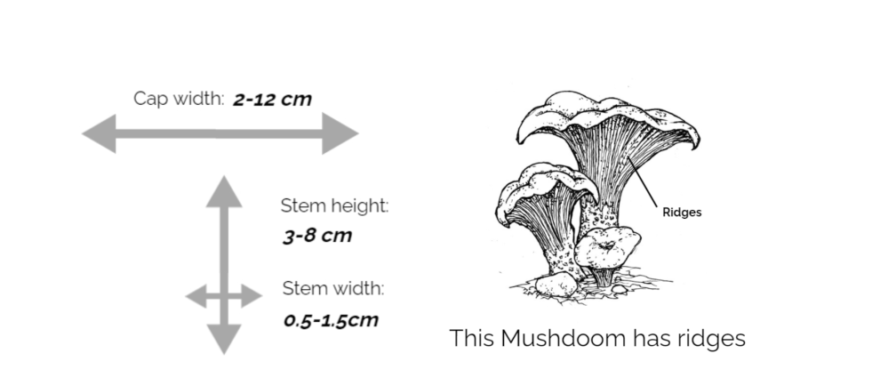These are a tasty delicacy anyone can forage from the forest, although learning how to identify chanterelle mushrooms is not always easy.
As a tree planter for many years now, I’ve had the opportunity to see chanterelle mushrooms countless times.
But I know not all of us have the time or had the opportunity. So I’ve decided to share my knowledge with you and teach you how to identify chanterelle mushrooms.
In this guide, you can expect to learn the following:
- The Chanterelle Mushroom Picking Season
- How to Identify Chanterelle Mushrooms
- Where Chanterelle Mushrooms are Found
- What Chanterelle Mushrooms Taste Like
- How to Store, Clean and Cook them
Let’s get started!
The Chanterelle Mushroom Picking Season
Chanterelle mushrooms (Cantarellus cirbarius) have a short picking season, they are usually ready to harvest from mid-summer to early fall. In the boreal forest that’s usually from early July to the end of August.

Although keep in mind that microclimates in your area affect the fruiting season, for example, you could find them earlier than that.
Factors like rainfall and weather affect when chanterelle mushrooms start to fruit. A hot spring season followed by heavy rainfall in early summer could trigger chanterelles to fruit earlier.
How to Identify Chanterelle Mushrooms




Chanterelles are small to medium sized mushrooms with a yellow exterior color and white interior flesh. The cap is slightly funnel shaped, with a depression at the center.
If you look at the edges of the cap, they curl inward, and flowing down to the stem are elevated ridges.
Chanterelles do have look-alikes, like the jack o’lantern (Omphalotus olearius) and the false chanterelle (Hygrophoropsis aurantiaca).
Chanterelle will almost always grow in single or pairs, but jack o’lantern grows in a large bundle. Knowing this, you can easily identify the two, but false chanterelles are harder to differentiate.
The Difference Between True Chanterelle & False Chanterelle

If you observe closely, there are many clues to tell them apart:
- The true chanterelle has ridges that are thicker than the false chanterelle.
- True chanterelle ridges fork prominently at the caps, while false chanterelle have delicate gills that run all the way up without forking.
- False Chanterelle caps are often quite round while true chanterelles start round but grow into unique shapes as they age.
- When you look at them from under, false chanterelle are more orange colored than true chanterelle.
- True chanterelle has a almondy, apricot-like smell that false chanterelle doesn’t have.
- If you split the true chanterelle in two, the inner flesh will be a clear white, while false chanterelle will be slightly orange.
Where Chanterelle Mushrooms are Found
They often grow around oaks, maple, beech, poplar, douglas fir, hemlock, and birch. They grow at the edge of treelines so old logging areas or trails are great spots to search. Old forests, as opposed to new forests, will have perfect conditions for picking chanterelles.
Chanterelle mushrooms grow in moist areas like creek beds. Places where water flows after rainfall are great spots to look at. In southern areas, they’re often found under blueberry bushes and in mountainy areas around douglas fir and white pine.
What Chanterelle Mushrooms Taste Like
Freshly picked chanterelles have a peppery, apricot flavor with slight earth tones. Strong preference for hand-picked chanterelle mushrooms rather than store-bought ones.
How to Store, Clean & Cook Chanterelle Mushrooms
How to Store Freshly Picked Chanterelles
Storing chanterelle mushrooms correctly is important to keep them in good condition. You never want to store them in a sealed plastic bag or container.
The best option is a brown paper bag or a container with a clean towel over it. Doing this will ensure you control the moisture and prevent any molds from growing.
Place in a dark, cool place until ready to cook.
How to Clean Chanterelles
Before you can eat them, you need to clean the mushrooms. As a general rule of thumb, not just with chanterelles but any other mushroom, you don’t want to run water on them.
If you take your mushrooms to the sink and clean them in running water, they will absorb water and puff up, and the true flavor of the chanterelle will be much milder.
What you want to do is take a clean hand cloth and gently rub off any dirt from the chanterelles. That’s really all you need to do, they will cook much better if they’re not wet.
How to Cook Chanterelles
Where I work, we are in camps up north in the forest, this means we have to cook all our food ourselves. Thankfully, there are some wonderful cooks that work with us, and they’ve taught me the secrets of cooking chanterelles to perfection.
Here’s what you want to do:
- Step 1: Heat up some oil in a pan until it’s quite hot, but not so hot that it smokes (canola or olive oil)
- Step 2: Place the sliced mushrooms in the pan and let them fry until they get golden, flip on other side.
- Step 3: When this is done, add in some chopped shallots and toss.
- Step 4: Finally, deglaze the pan with white wine and lower the heat, simmer for a bit.
- Step 5: By now it should smell delicious, final touch is to add a bit of butter with salt + pepper. Enjoy!
Conclusion
That’s it! That should have covered everything you need to know to find chanterelles yourself and enjoy these wonderful mushrooms.
But if you have additional questions, write them down below and I will do my best to answer!
Happy hunting!

